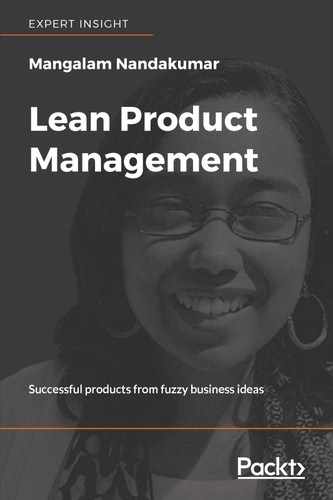Most teams tend to get carried away when seeing a product backlog that has features that offer a great opportunity to employ cool, cutting edge tech. Everyone wants to get their hands on it. It excites the team to go and build a product, even when there are so many products available on the market that can meet business needs quite well.
There are two broad categories of a product in terms of the value that it can produce. The feature can be an enabler or it can be a differentiator. We briefly discussed enablers and differentiators in Chapter 5, Identify the Impact-Driven Product. An enabler is something that can help to support the core business impact. The enabler by itself may not be core to the business, but it helps to deliver or measure business impact. A differentiator, in contrast, is the business itself. One or more core aspects of the business depend on the differentiator. This is what qualifies as the IP (intellectual property, which is the intangible value created from patents, copyright, or creativity) of a product. Without this differentiator (or secret sauce), your business has no edge over the competition. When a feature is easy to copy, then soon enough our competitors will follow suit. They will learn from our mistakes and gaps in product experience and offer better value to customers. After all, the second mouse gets the cheese.
Even enablers can give a competitive advantage to our business, purely by helping the business to respond or scale to market needs. For example, banks that undertake digital transformations are essentially looking at online banking solutions as enablers. Their core banking model hasn't changed, but they are looking at digital channels to enable their existing strength. Digital solutions help to improve customer experience and reach, while reducing the cost of operations. Mobile apps act as a channel for digital banking. They can give the first banks that adopt them, a competitive edge. The enabler acts as a differentiator for a while, but then, mobile apps are easy to replicate, and subsequent versions from competitors will improve upon user experience and customer impact.
In general, if our product feature is a differentiator, then it is best to build it in-house. This gives the business the maximum leverage of being able to shape up the product, giving us full control on what we offer and how we offer it. However, if our product feature is an enabler, then the first decision to make is whether there is an existing solution that we could leverage. The following are some of the aspects that we want to consider when evaluating an off-the-shelf solution:
- How well can it meet our needs?
- Can it deliver on all of our success criteria?
- Does it integrate well with the rest of our product?
- Does it meet our pricing needs?
- Does it have unreasonable maintenance overheads?
- Is it hard to on-board?
The chances are that if we look hard enough, there is usually a solution to be found. We need to ask these questions before we decide to build from scratch:
- Is the feature a core differentiator for the business?
- Are our functional flows processed as standard and can they be met by an off-the-shelf product?
- Is it critical for this feature to be rolled out with our branding?
- Do we have specific/unique legal, compliance, and regulatory requirements that cannot be fulfilled by an off-the-shelf product?
- Does the commercial proposition work well for us?
- Does it integrate well with the rest of the technology stack used in our core product?
- Is it easy to purchase, set up, and get started with the off-the-shelf product?
- Is there a model of support for the off-the-shelf product that can meet our needs?
- Do we have a partner who can build this for us?
- Do we have the time and people to provide the oversight needed in order ensure that we have the right product delivered?
Based on the answers to the preceding questions described, for a feature idea that is an enabler, we can generally interpret whether or not to build the feature from scratch:

This can serve as a guideline for deciding where to invest a product team's time.
